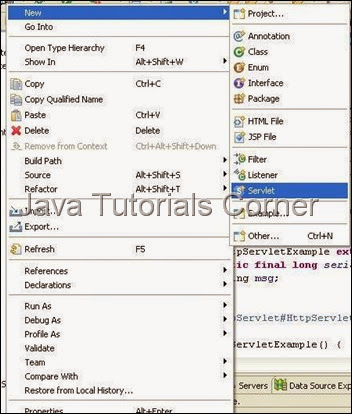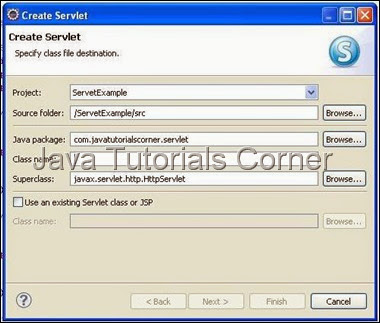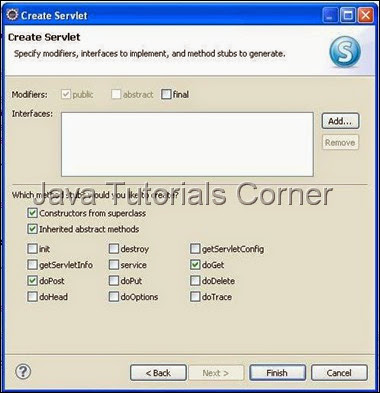In this tutorial we are going to see about ServletConfig interface with example program.
A servlet configuration object used by a servlet container to pass information to a servlet during initialization.
Methods in ServletConfig Interface
getServletConfig(); method of Servlet returns instance ServletConfig .
Now see the example program.
1. Create new Dynamic web project by choosing File –> New –> Dynamic Web Project .
2. Create the Project called ServletExample as given below.

3. Create package called com.javatutorialscorner.servlet under ServletExample.
4. Create Servlet called ServletConfigExample as shown in figure.


5. Click Next it will show URL mapping.You can edit Servlet URL if you need.
6. Click Next it will show methods available in HttpServlet. Select appropriate method you need.

7. By default your servlet will be mapped in web.xml, if your servlet not mapped in your web.xml use the following configuration to map the servlet in your web.xml
Servlet Mapping
web.xml
<init-param>....</init-param>
The init-param is sub element of servlet which is used to pass the Initialization parameter to Servlet
8. Add the required code inside doGet() method.
ServletConfigExample.java
9. Now save and Run the servlet, Run As –> Run on Server – Select your web Server to run the servlet. ( see How to configure tomcat in eclipse)
http://www.javatutorialcorner.com/2014/03/how-to-configure-tomcat-in-eclipse.html
10.call the URL which is mapped in web.xml.
http://localhost:8080/ServletExample/ServletConfigExample
Output

A servlet configuration object used by a servlet container to pass information to a servlet during initialization.
Methods in ServletConfig Interface
| S.No |
Methods with Description
|
| 1 | String getServletName() Returns the name of this servlet instance. The name may be provided via server administration, assigned in the web application deployment descriptor, or for an unregistered (and thus unnamed) servlet instance it will be the servlet's class name. |
| 2 | ServletContext getServletContext() Returns a reference to the ServletContext in which the caller is executing. |
| 3 | String getInitParameter(String name) Gets the value of the initialization parameter with the given name. |
| 4 | java.util.Enumeration<java.lang.String> getInitParameterNames() Returns the names of the servlet's initialization parameters as an Enumeration of String objects, or an empty Enumeration if the servlet has no initialization parameters. |
Now see the example program.
1. Create new Dynamic web project by choosing File –> New –> Dynamic Web Project .
2. Create the Project called ServletExample as given below.

3. Create package called com.javatutorialscorner.servlet under ServletExample.
4. Create Servlet called ServletConfigExample as shown in figure.


5. Click Next it will show URL mapping.You can edit Servlet URL if you need.
6. Click Next it will show methods available in HttpServlet. Select appropriate method you need.

7. By default your servlet will be mapped in web.xml, if your servlet not mapped in your web.xml use the following configuration to map the servlet in your web.xml
Servlet Mapping
<servlet>
<servlet-name>Your Servlet Name</servlet-name>
<servlet-class>Fully Qulaified Servlet Class Name</servlet-class>
</servlet>
<servlet-mapping>
<servlet-name>Your Servlet Name</servlet-name>
<url-pattern>/URL to Call Servlet</url-pattern>
</servlet-mapping>
web.xml
<?xml version="1.0" encoding="UTF-8"?> <web-app xmlns:xsi="http://www.w3.org/2001/XMLSchema-instance" xmlns="http://java.sun.com/xml/ns/javaee" xmlns:web="http://java.sun.com/xml/ns/javaee/web-app_2_5.xsd" xsi:schemaLocation="http://java.sun.com/xml/ns/javaee http://java.sun.com/xml/ns/javaee/web-app_3_0.xsd" id="WebApp_ID" version="3.0"> <display-name>ServetExample</display-name> <welcome-file-list> <welcome-file>index.html</welcome-file> <welcome-file>index.htm</welcome-file> <welcome-file>index.jsp</welcome-file> <welcome-file>default.html</welcome-file> <welcome-file>default.htm</welcome-file> <welcome-file>default.jsp</welcome-file> </welcome-file-list> <servlet> <servlet-name>ServletConfigExample</servlet-name> <servlet-class>com.javatutorialscorner.servlet.ServletConfigExample</servlet-class> <init-param> <param-name>path</param-name> <param-value>JTC</param-value> </init-param> </servlet> <servlet-mapping> <servlet-name>ServletConfigExample</servlet-name> <url-pattern>/ServletConfigExample</url-pattern> </servlet-mapping> </web-app>
<init-param>....</init-param>
The init-param is sub element of servlet which is used to pass the Initialization parameter to Servlet
8. Add the required code inside doGet() method.
ServletConfigExample.java
package com.javatutorialscorner.servlet;
import java.io.IOException;
import java.io.PrintWriter;
import javax.servlet.ServletConfig;
import javax.servlet.ServletException;
import javax.servlet.http.HttpServlet;
import javax.servlet.http.HttpServletRequest;
import javax.servlet.http.HttpServletResponse;
/**
* Servlet implementation class ServletConfigExample
*/
public class ServletConfigExample extends HttpServlet {
private static final long serialVersionUID = 1L;
/**
* @see HttpServlet#HttpServlet()
*/
public ServletConfigExample() {
super();
// TODO Auto-generated constructor stub
}
/**
* @see HttpServlet#doGet(HttpServletRequest request, HttpServletResponse
* response)
*/
protected void doGet(HttpServletRequest request,
HttpServletResponse response) throws ServletException, IOException {
// TODO Auto-generated method stub
ServletConfig servletConfig = getServletConfig();
String path = servletConfig.getInitParameter("path");
response.setContentType("text/html");
PrintWriter writer = response.getWriter();
writer.write("<!DOCTYPE html PUBLIC \"-//W3C//DTD HTML 4.01 Transitional//EN\" \"http://www.w3.org/TR/html4/loose.dtd\">\n"
+ "<html><head><meta http-equiv=\"Content-Type\" content=\"text/html; charset=ISO-8859-1\"><title>Java Tutorials Corner - Servlet - Servlet Config Example</title>"
+ "</head><body><h1>Java Tutorials Corner - Servlet - Servlet Config Example</h1><table><tr>"
+ "<td> Init Param : </td><td>"
+ path
+ "</td></tr></table></body></html>");
}
/**
* @see HttpServlet#doPost(HttpServletRequest request, HttpServletResponse
* response)
*/
protected void doPost(HttpServletRequest request,
HttpServletResponse response) throws ServletException, IOException {
// TODO Auto-generated method stub
}
}
9. Now save and Run the servlet, Run As –> Run on Server – Select your web Server to run the servlet. ( see How to configure tomcat in eclipse)
http://www.javatutorialcorner.com/2014/03/how-to-configure-tomcat-in-eclipse.html
10.call the URL which is mapped in web.xml.
http://localhost:8080/ServletExample/ServletConfigExample
Output






0 comments:
Post a Comment